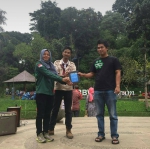Getting to Know Underutilized Fruit Trees, Less Favorite but Rich in Benefits
By Adi Permana
Editor Adi Permana

BANDUNG, itb.ac.id—Underutilized Fruit Trees (UFT) are a group of trees whose fruit can be consumed but tend to be underutilized and not widely known because not cultivated on a large scale. The existence of UFT is still missed due to the public's lack of knowledge.
Angga Dwiartama, Ph. D, a lecturer and researcher at SITH ITB, researched UFT and recorded its existence in several indigenous peoples in West Java. He and SITH researcher Mochammad Fikry Pratama chose indigenous peoples as their objects. Angga said indigenous peoples have a better track record with biodiversity inherited from their ancestors.
"We used a combination method: interview, observation, exploratory, and vegetative analysis in seven indigenous communities in West Java," he added in the Bincang Seru Buah Langka (BISBUL) event organized by Rumah Pila on Saturday (28/8/2021).
This research took three years. In their first year, they started visiting indigenous peoples and planting UFT at ITB Jatinangor Campus. The following year, they explored the existence of UFT in various markets in West Java and surveyed 345 young people related to several UFTs in West Java.
Based on the survey results, most people do not know about UFT. Some just know but have never seen or even tasted it. In the third year, they collaborated with Rumah Beara and The GoodLife to introduce various UFT types and processings.
According to Fikry, UFT is not popular among young people because of the disconnection of knowledge from the previous generation. UFT is also not a top priority for planting, so the remaining population is quite threatened and rarely found. Unmaximized utilization makes these various fruits often become waste, and only a few can be sold.

Steps that can be taken to popularize UFT are to promote and spread knowledge about UFT. These fruits are rich in nutrients and vitamins. Although some fruits, including UFT, are unpalatable, they can be transformed into unique and impressive cuisines. Angga was also in the middle of completing a book about UFT, which collaborates with high school students to make plant illustrations to introduce UFT, especially to the younger generation.
The unpopularity of the UFT could make it threatened by extinction. By knowing and utilizing UFT, we also contribute to maintaining food security, especially fruit, and helping the next generation enjoy local fruit. UFT plant cultivation will also contribute oxygen, prevent erosion, and become a habitat for various animals. Awareness is the primary key that can increase the capacity of educational institutions, the private sector, and individuals to care for the existence of rare fruit.
Reporter: Maharani Rachmawati Purnomo (Oceanography 2020)
Translator: Zahra Annisa Fitri (Urban and Regional Planning, 2019)

.jpg)
.jpg)
.jpg)
.jpg)
.jpg)


